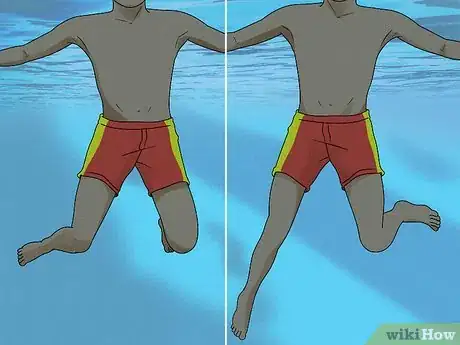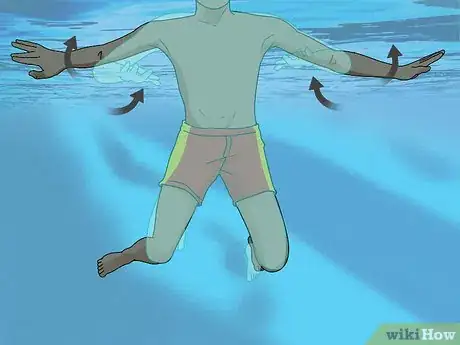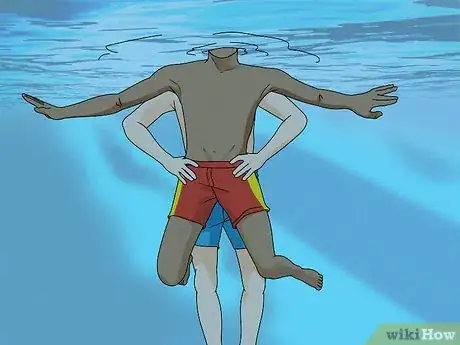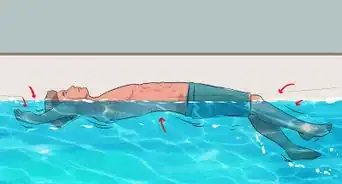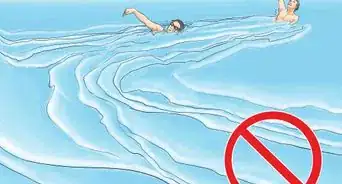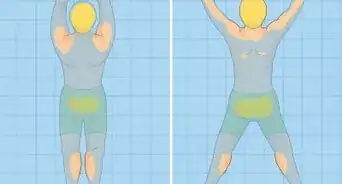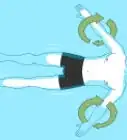X
wikiHow is a “wiki,” similar to Wikipedia, which means that many of our articles are co-written by multiple authors. To create this article, 22 people, some anonymous, worked to edit and improve it over time.
This article has been viewed 157,053 times.
Learn more...
This is the most efficient method of treading water. It's used by water polo players but is great for anyone who wants to tread water.
Steps
-
1Get in a pool and position yourself vertically in the water.[1]
-
2Start breaststroke (frog style) kicking to stay afloat, but only kick one leg at a time.[2]Advertisement
-
3At the same time keep your arms in front of you about shoulder width apart moving back and forth left to right to keep you balanced and to help keep you afloat.[3]
-
4Spread your legs out as far as you comfortably can, and bring them your quads up as if you were sitting in a chair,(approx 90 degree angle between legs and abs) and kick each leg separately in a circular motion (Right leg in counter-clockwise motion, left leg in clockwise motion)[4]
-
5It may take some time learning to keep your hips stable while doing this, so focus on that or have someone hold your hips in place.
Advertisement
Community Q&A
-
QuestionI find it hard to keep my legs straight when swimming. What can I do?
 Community AnswerJust remember to point your toes more, but only a little. Otherwise, you could get cramp.
Community AnswerJust remember to point your toes more, but only a little. Otherwise, you could get cramp. -
QuestionHow long does it take to get used to the egg beater?
 Community AnswerIt can vary. Just keep practicing and using it, and it will become more natural.
Community AnswerIt can vary. Just keep practicing and using it, and it will become more natural. -
QuestionWhen I kick to tread, I start drowning in water. What do I do?
 Community AnswerMake sure that when you are eggbeating that you keep your feet flexed (pull your toes upwards towards your leg) and that your legs are moving inward. Your right leg will turn counter-clockwise, and your left leg will turn clockwise. Also, move your hands back and forth with your palms facing downwards (like you are spreading butter on toast): this is called sculling.
Community AnswerMake sure that when you are eggbeating that you keep your feet flexed (pull your toes upwards towards your leg) and that your legs are moving inward. Your right leg will turn counter-clockwise, and your left leg will turn clockwise. Also, move your hands back and forth with your palms facing downwards (like you are spreading butter on toast): this is called sculling.
Advertisement
Warnings
- As tiring as it is, treading in this fashion is the most efficient way to keep yourself afloat, and consistent work will adapt your legs to the action.⧼thumbs_response⧽
- When you first learn this it can be tiring, but after doing it for a couple of days you get used to it and it becomes highly effective. If you are just learning it do not try to stay in very deep water for too long!⧼thumbs_response⧽
- Be alert for fatigue. If you sense yourself getting exhausted, switch to a lower energy method of staying afloat.⧼thumbs_response⧽
Advertisement
References
About This Article
Advertisement

